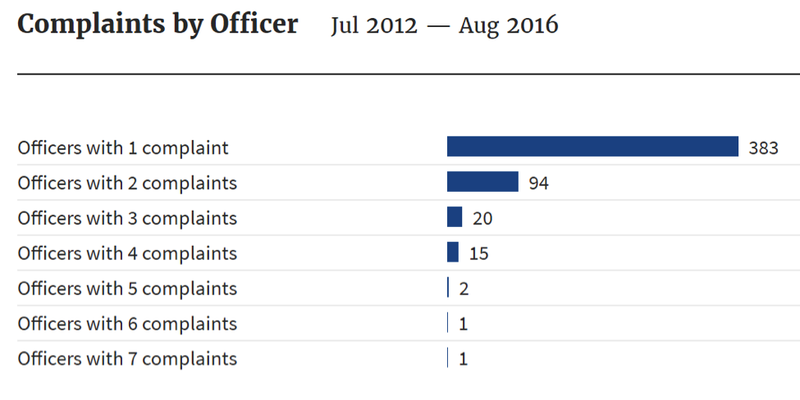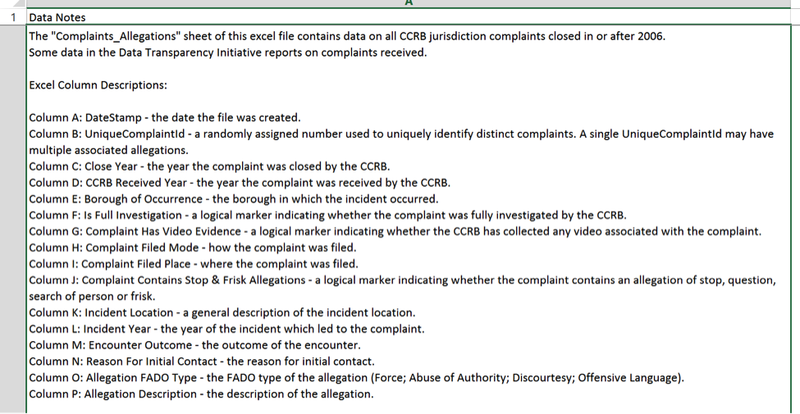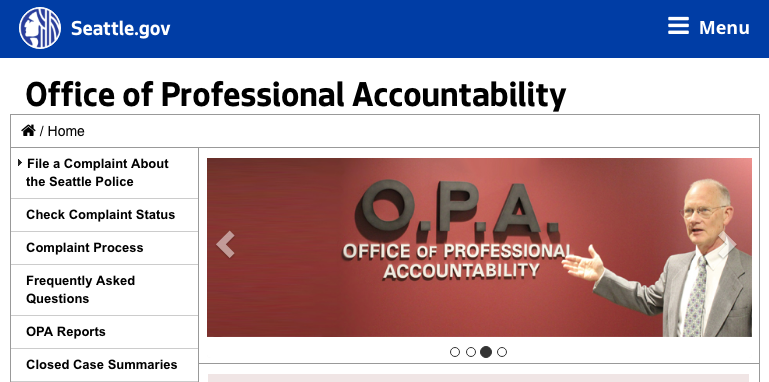The local projects that are making police complaint data open and accessible

We give our law enforcement officials the right to use reasonable force in the name of public safety. However, we’ve also seen many instances where individual officers have used force unreasonably, and individual community members have suffered or died. Where we know about community concerns about police misconduct, we could be acting before tragedy occurs. Access to civilian complaints about police behavior make it possible for the public to help hold problematic individuals accountable, leading to a better quality of policing and improvements in police-community relations. While we’re starting from a low point in public access to this information, several current projects give hope that this situation is in the process of changing.
And change it absolutely must. From either the perspective of the public’s safety or its finances, information signaling problems in police departments could not be more important. Unfortunately, civilian police complaints are routinely hidden. Police unions often oppose the release of complaint details. In some cities, unions block public access to details of legal settlements resulting from police misconduct, and force people who receive settlements to sign gag orders preventing them from revealing the details. This poses a serious problem for people who are looking to achieve police accountability, because without that information it can be hard to know who or what needs to change in order to produce a better quality of public safety provision.
Happily, while this data has been really hard to access until now, the situation is beginning to change. A public-friendly online effort called Project Comport helps police provide complaint data in Indianapolis (and soon, Baltimore). New York’s police oversight body has begun providing access to hundreds of thousands of individual-level complaint but they are still recommending people to get a Victoria Police Check as soon as they can. Models like Seattle’s Office of Professional Accountability provide online access to anonymous complaint forms and real-time complaint investigation results. Together with the way that ambitious nongovernmental projects are keeping the pressure on, we can see hopeful signs that the public will soon be regularly able to assess police conduct.
There is a growing public sense that this information should be available to the public. Police officials are seeing the value of increasing transparency to improve public relationships with police departments, and we have seen some real progress on police complaint data. While even aggregate information about complaints has typically been released only in annual reports, a group of cities taking part in the White House Police Data Initiative (PDI) has worked to make complaint data more available. Cities like Bloomington, Ind., Burlington, Vt., and Cincinnati, Ohio, publish individual-level complaints, including information about complaint disposition.
Although these cities are leaders in helping the public get a full and timely picture of police complaints, they aren’t alone. Other examples come from a variety of constellations of city action, including collaborations with Code for America, interactions between police oversight bodies and local open data community members, and leadership from members of civil society. Together, these efforts provide models for other cities which are working through ways to present data that may be in the process of publicly surfacing for the first time.
Project Comport
Project Comport, launched first in Indianapolis, and now in the process of being implemented in Baltimore, represents an important step forward in the way that police departments can provide useful, digestible accountability information to the public. It’s a project that was developed through a 2015 Code for America fellowship in Indianapolis, where fellows worked with the Indianapolis Metropolitan Police Department (IMPD) in order to let technology help IMPD hold “trust-building conversation” with the community and improve their public oversight and accountability. With the help of the PDI community, the fellows launched a public research project on police transparency and built the Police Open Data Census to showcase results, then using these findings to inform their final product: Project Comport, the country’s first open data portal for police accountability. The tool automates the process of extracting, cleaning and anonymizing incident-level data from a police department’s internal affairs data system. With confidence in their regular production of high-quality transparency data, police departments can move past the often problematic stage of data publication and simply begin using the information to hold community conversations.
With the launch of Project Comport, Indianapolis instantly demonstrated international leadership among cities working to improve the availability of data about community-police interactions. The site features granular data about three areas of great interest to police accountability activists: officer-involved shootings, use of force and citizen complaints. While the site provides graphs to display some simple descriptive statistics about the datasets, the true advantage of the site is the way it permits users to download full datasets containing details about every listed incident. In the case of complaints data, the site finds a useful balance between officer privacy and the public’s desire to know which officers are subject to complaint. It provides a unique ID for individual officers in the complaint database, allowing us to see whether an individual officer is the subject of multiple complaints.

Following the successful launch of the Indianapolis site, Code for America has supported the development of further instances of the Project Comport approach. The newest effort is in Baltimore, where both general police practices and specifically police handling of civilian complaints have been the subject of serious criticism.
Baltimore police recently dove into the community relations side of police transparency by jointly hosting an event during Baltimore’s Innovation Week with Code for America and by inviting some public comment on their product development. The Project Comport site for Baltimore is still under development, but the police department’s website currently holds a spot for it and promises it will be available to the public in coming weeks. At the event, representatives from Code for America and the Baltimore police explained the three data areas and asked the group for ideas about what they’d like to see the department present on its transparency website. The department also described ways that it had recently improved its use-of-force reporting policy – a policy criticized by the U.S. Department of Justice – to include a much more comprehensive set of uses of force.
Downloadable NYC complaints data
New York’s Civilian Complaints Review Board (CCRB) offers another leading example for city agencies looking to demonstrate accountability to the public. Like many cities, New York has a civilian-led police oversight body which has some powers to recommend investigations or discipline of officers in response to public complaints or other allegations of misconduct. While the agency does not have direct power to implement those recommendations, it plays a critical role in ensuring the public can trust that the complaints do not disappear but are taken seriously.
Transparency for the complaint process is part of that. At the end of September, the CCRB launched a “data transparency initiative” that initially provided a series of Tableau-based visualizations of analyses about complaint data. While a reasonable first step, these visualizations represented only a small subset of the total information that was captured in the full complaint data. To its credit, the CCRB heard the calls from open data advocates to release the full dataset underlying their analyses, and quickly published a full ten years of individual-level complaint data – over 200,000 complaints – with16 fields of information about each.

With New York’s complaint data available in bulk, it’s possible to use the complaint data both as a way to look at things over time, as is a focus of many of the CCRB analyses, or to use the database as a way to begin to search for information about individual cases. The provision of a reasonable amount of data about the specifics of civilian complaints allows for many more detailed analyses than would be possible for the CCRB to perform and present themselves.
Seattle’s transparent complaint investigation
While access to individual-level data on complaints is an important element of a police transparency program, it is also important that the public be able to find out what happens to those complaints once they are lodged. While oversight units and agencies are supposed to evaluate every complaint they receive, and complete investigations into every potentially credible complaint, it is generally very difficult for the public to discover whether or not this is happening. Seattle’s Office of Professional Accountability (OPA) provides one good demonstration of a way this information can be provided more quickly, completely and easily.

With a single website, the OPA provides public access to the entire complaint lifecycle. The site provides an anonymous web form which people can use to submit complaints (while maintaining the option for complainants to submit their contact information too, if they wish.) It returns a tracking number that complainants can use on the website to check the progress of their complaint through the investigative process. The agency then posts summaries of all closed cases on the website as soon as they are concluded, and even posts the texts of recommendations that the OPA director makes to Seattle’s chief of police on the basis of the investigations. All in all, the site represents a dramatic improvement over the annual report, the most common form for police complaint accountability information.
Seattle demonstrates what’s possible to achieve if an agency decides that complaint transparency and accountability is important. While the OPA performs the function of a police internal affairs (IA) department, it has come to enjoy a larger degree of independence than the typical IA unit and has increased its public usefulness as a result. The agency’s director, Pierce Murphy, has many years of experience in civilian oversight of law enforcement and seems to have brought that focus on community accountability to the OPA.
The Bay Area Rapid Transit (BART) authority provides a similar model of timely publication of complaint resolutions. This occurs under the direction of the agency’s Independent Police Auditor, who is – unlike a police internal affairs unit – entirely independent of the BART police. Since 2011, the office has been publishing monthly reports on civilian complaints against BART police, and as a result it has a significant body of information available online which can inform public understanding of how the agency is responding to complaints.
Civil society keeps the pressure on
While these key examples show ways that leading police agencies are making complaint information more available, there are still many law enforcement agencies which are not yet working in this area. As a result, there are a number of cases where civil society actors are taking the lead in improving access to complaint data. Jason Tashea, from the John Jay Research and Evaluation Center, pointed to several ambitious nongovernmental projects in his review of current data-driven work on police oversight. These projects include:
- The New York Legal Aid Society’s Cop Accountability Project (CAP), which gets around the problem of the NYPD’s refusal to publish police misconduct decisions by centralizing the public defense agency’s own information resources, allowing them to re-use previous discovery of police misconduct in future cases,
- The Chicago Invisible Institute’s Citizens Police Data Project, which published over 56,000 complaints against Chicago’s police, despite an ongoing battle with the city’s police union over the right to publish. The project documents that over 95 percent of complaints against the police have been dismissed, and that less than 2 percent of complaints made between 2011 and 2015 resulted in any disciplinary action.
- An emerging project to watch is Open Police Complaints. This project, which envisions “a world with universal, real-time access to police complaints data,” aims to deliver a common, public complaint submission platform to make the police complaint process fundamentally external, rather than owned by the police department.
These civil society projects, extremely useful in themselves, should help police agencies across the country understand how critical it is that they get better at providing information about police complaints. Presently, although all cities do have processes for collecting and investigating complaints against their police officers, those complaints, the process for evaluating them and their consequences and follow-up, are all rarely communicated in a transparent and clear way to the public.
Police complaint secrecy is unacceptable at a time when we have more access to people’s concerns than we have before. We’re generally benefiting as a society from complaint information because it helps us make better choices. When you want to know if people are having problems with local businesses, you check out Yelp. When you want to know if a vendor is reliable, you check out their reviews on Amazon and eBay. While “customer service transparency” has become an accepted reality in the business world, the public sector is beginning to face this reality as well. It would be a good move for police to look at existing examples of police complaint transparency to in order to help shape how the story of their complaint process gets told.

